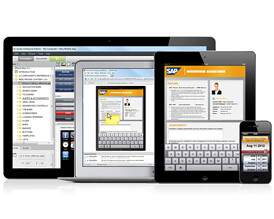IRISE:TECHNOLOGY AUGMENTING WORK
/The consumerization of information technology isn't just about giving users what they want when they want it. Consumerization may also mean bringing the consumer into the design process so that they can get what they want, when they want it, and in the form that they are expecting. iRise is working to change a 30 year-old process about how business and information technology professionals communicate about requirements in order to make consumer/designer co-design a reality.
iRise has built a simulation platform, a kind of computer-aided design for business software that moves the information technology requirements process from giant documents (text) to simulations of the software the business user is asking for. Users are presented with a working simulation of the application rather than a 1000 page document of requirements that is of more value to the development team than the users. This is a case of a technology serving as a translator between different sets of expertise. This is technology augmenting our work.
I asked Emmet Keeffe, chief executive officer and co-founder, if this was an extension of lean design. My thinking was that in terms of producing a minimal viable product to be tested against the users' expectations -- the lean approach -- iRise could enable quick, evidence-based design pivots until you get it right.
He said that, yes, they use the terms, but more often they talk about enabling agile design. They see iRise as filling the gap between the number of developers with the powerful soft skills to run an agile sprint and the number of projects to be done.
We empower business analysts to run those sprints. This can cut project time and costs by 50 percent. We've been evangelizing and now are seeing big benefits. There is some change management.. [and so this has taken some time.]
NPower, a non-profit that provides information technology support and training to non-profits and young adults who otherwise might not be able to afford it, uses iRise. Frank Pedersen, NPower Chief Marketing Officer, says:
Demonstrating applications with iRise creates a more efficient model for working. It has helped us establish common ground with our clients and results in better applications with user interfaces that people are comfortable with.
Work, whether in information technology or other industries, is shifting to require greater and greater cross-talk across areas of expertise -- at the same time that we need deeper and deeper expertise into our own abilities. Our careers are demanding what could be conflicting goals: Greater personal expertise and greater understanding of the deep expertise of others such that you can work together on complex projects. How do you have enough time to do both?
IBM and IDEO are known to talk about "T-shaped" people who have deep expertise in their own areas, but enough breadth to talk to experts in other areas. Companies like General Electric used to support this kind of training via job rotations, yet GE recently acknowledged that spending time in career development that way isn't possible given the deep expertise demanded in today's environments.
For most organizational problems there is some mix of human, technical, and organizational process that can provide a solution. If deep discussions across information technology customers and developers isn't possible due to language differences, then tools like iRise provide a common ground to help in the translation. iRise lets the customer see what the developer thinks is the solution and provide feedback that can be quickly integrated and checked again. iRise then supports the developer by jumpstarting 30 to 50% of the code, Keeffe says.
In what other ways can technology augment our work communication?
I use Rapportive (recently purchased by LinkedIn) to give me current context (recent tweets & other posts) about people I'm communicating with. MIT scholars have created tools they call SixthSense to provide a connection from Internet information and the real world - a bit like the Google Glass project may offer in a glasses interface. In these three examples my communication and work may be enhanced through augmentation with information, but the connection to creating a common ground of understanding is not as clear. iRise gives us hints of the goals we should be working toward -- new ways of using technologies to bring people together and hands on with projects, even when speaking different professional languages.
Perhaps this is the missing "volume" that Ben Kepes and I have been looking for in our discussions of Triangle-Shaped people. We've been thinking that triangle skill sets may be even more valuable than T-Shaped ones. Triangle skill sets bring greater volume to collaboration as there is more than just a surface level of shared understanding. Perhaps augmenting technologies can combine with human skills to create exceptional collaborations as expertise and technical tool-sets combine in new ways.
As you may know, I'm working on a new project and would appreciate your examples to include. Thinking about your own industry, in what ways can human expertise and technically-augmented common ground support your work?
A shorter version appeared on Technorati
Image courtesy of iRise.








